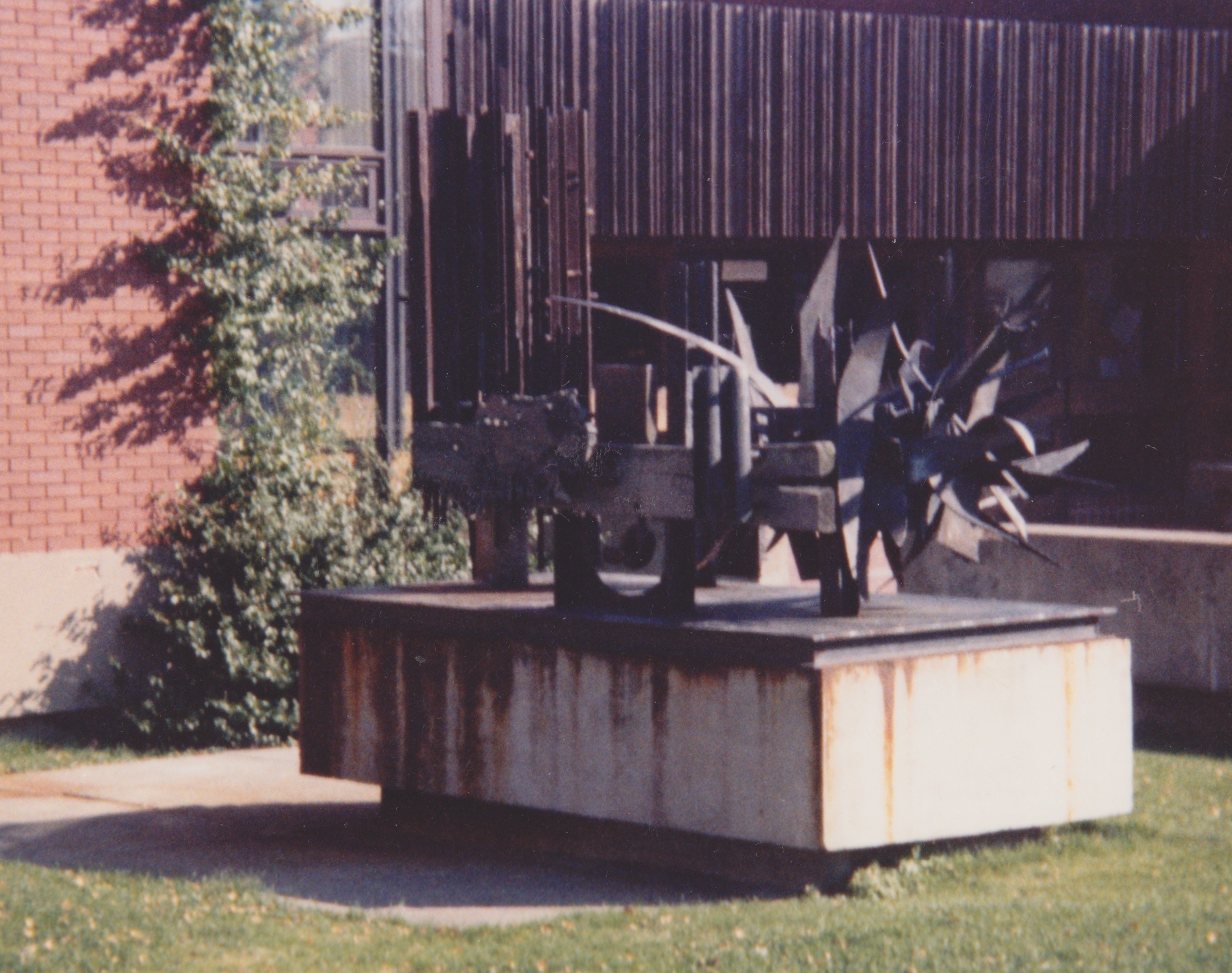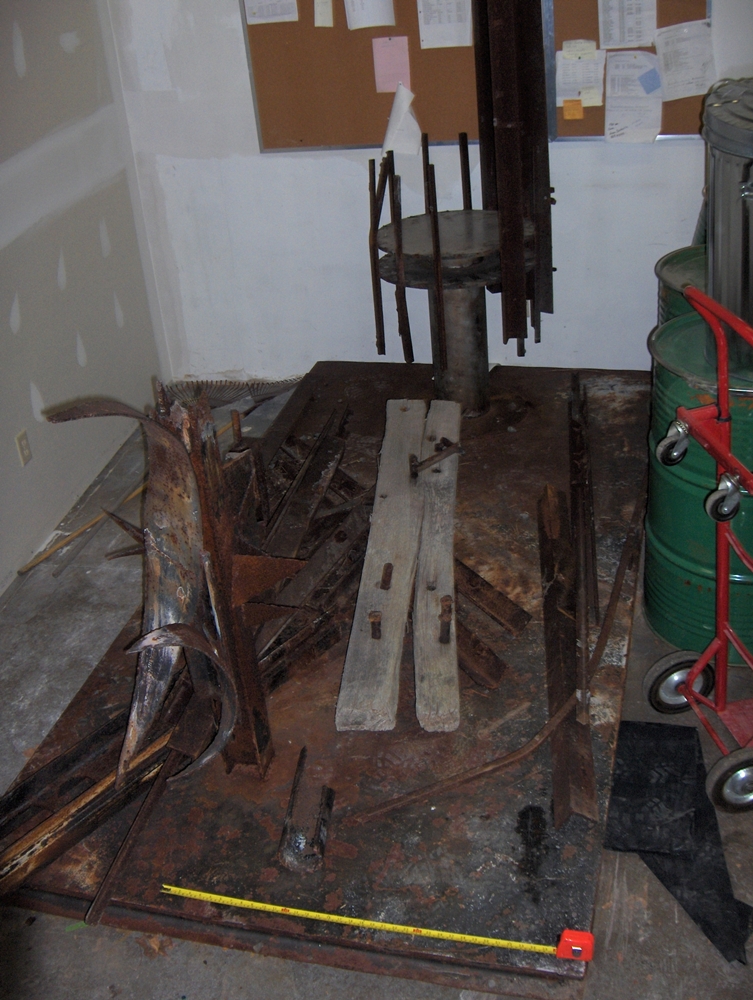Halifax Explosion Memorial Sculpture on:
[Wikipedia]
[Google]
[Amazon]
The ''Halifax Explosion Memorial Sculpture'' was a work of
 The sculpture was made of steel,
The sculpture was made of steel,
 Over 40 years the sculpture suffered some damage from exposure to weather. Damaged and detached parts were removed and stored at the library. In 2004 the sculpture was dismantled during library renovations which included reconstruction of the library courtyard. The sculpture was replaced by a new work ''North is Freedom'' by Doug Bamford and Stephen Brathwaite. According to the Halifax Regional Municipality, the sculpture could not be repaired and posed a safety risk and had to be stored while its fate was decided.
The sculpture was broken into pieces which were left unmarked and stored at various warehouses and city works yards across the city. A 2006 report by a consultant urged the city to identify the parts and bring them together. However this did not happen and several parts have disappeared including the key component known as "the doll", the bronze casting representing the children of the explosion. The fragment from ''Mont-Blanc'' which was included in the sculpture has been preserved at the
Over 40 years the sculpture suffered some damage from exposure to weather. Damaged and detached parts were removed and stored at the library. In 2004 the sculpture was dismantled during library renovations which included reconstruction of the library courtyard. The sculpture was replaced by a new work ''North is Freedom'' by Doug Bamford and Stephen Brathwaite. According to the Halifax Regional Municipality, the sculpture could not be repaired and posed a safety risk and had to be stored while its fate was decided.
The sculpture was broken into pieces which were left unmarked and stored at various warehouses and city works yards across the city. A 2006 report by a consultant urged the city to identify the parts and bring them together. However this did not happen and several parts have disappeared including the key component known as "the doll", the bronze casting representing the children of the explosion. The fragment from ''Mont-Blanc'' which was included in the sculpture has been preserved at the
Paul Dunphy, Director, Community Development “Status Update - Halifax Explosion Memorial” Halifax Regional Municipality February 2, 2011
Steel sculptures in Canada 1966 sculptures Monuments and memorials in Nova Scotia Outdoor sculptures in Canada Culture of Halifax, Nova Scotia Bronze sculptures in Canada Wooden sculptures in Canada Destroyed sculptures 1966 establishments in Canada Firefighting memorials
public art
Public art is art in any media whose form, function and meaning are created for the general public through a public process. It is a specific art genre with its own professional and critical discourse. Public art is visually and physically acce ...
in Halifax, Nova Scotia
Nova Scotia ( ; ; ) is one of the thirteen provinces and territories of Canada. It is one of the three Maritime provinces and one of the four Atlantic provinces. Nova Scotia is Latin for "New Scotland".
Most of the population are native Eng ...
, created in 1966 by the Quebec artist Jordi Bonet
Jordi Bonet i Godó, known professionally as Jordi Bonet (7 May 1932 – 25 December 1979), was a Spanish-born Canadian painter, ceramist, muralist, and sculptor who worked principally in Quebec.
Life and work
Born in Barcelona, Spain of Cata ...
to commemorate the Halifax Explosion
On the morning of 6 December 1917, the French cargo ship collided with the Norwegian vessel in the waters of Halifax, Nova Scotia, Canada. The ''Mont-Blanc'', laden with high explosives, caught fire and exploded, devastating the Richmond ...
. The sculpture was located at the Halifax North Memorial Library but was dismantled in 2004 by the Halifax Regional Municipality and accidentally destroyed while in storage.
Background
On December 6, 1917, almost 2000 people were killed by the accidental explosion of the French ammunition ship ''Mont-Blanc'' inHalifax Harbour
Halifax Harbour is a large natural harbour on the Atlantic coast of Nova Scotia, Canada, located in the Halifax Regional Municipality. Halifax largely owes its existence to the harbour, being one of the largest and deepest ice-free natural harbo ...
. The Halifax Relief Commission was created to take over relief and rehabilitation work, as well as the reconstruction of the city. In 1965 the Relief Commission donated $100,000 to assist construction of library branch in the North End of Halifax which would serve as a memorial to those killed in the disaster. The library was built in 1966. As part of the new library, architects Keith L. Graham & Associates commissioned artist Jordi Bonet to create an outdoor sculpture that would commemorate the disaster and rebirth of the city. Bonet was a Spanish-born sculptor who worked in Quebec
Quebec ( ; )According to the Canadian government, ''Québec'' (with the acute accent) is the official name in Canadian French and ''Quebec'' (without the accent) is the province's official name in Canadian English is one of the thirtee ...
and who was known for his work with public art and spirituality.
Design
 The sculpture was made of steel,
The sculpture was made of steel, iron
Iron () is a chemical element with Symbol (chemistry), symbol Fe (from la, Wikt:ferrum, ferrum) and atomic number 26. It is a metal that belongs to the first transition series and group 8 element, group 8 of the periodic table. It is, Abundanc ...
, bronze and wood
Wood is a porous and fibrous structural tissue found in the stems and roots of trees and other woody plants. It is an organic materiala natural composite of cellulose fibers that are strong in tension and embedded in a matrix of lignin ...
. Measuring 15 by 7 feet, it consisted of four parts. The first was a ball of jagged curved steel blades facing the street which symbolized the explosion. An actual fragment from the ''Mont-Blanc'' ammunition ship was attached to the base. The second part faced north and used bronze and battered wood to symbolize the human cost of the tragedy. It included a bronze casting with the outline of a doll symbolizing the hundreds of children who died. A third part facing south included a battered cogwheel representing industry and a bronze casting of a flower representing life. The fourth part, closest to the library, was a circular vertical column of uniform steel rods depicting the rebirth of the city.
Removal and destruction
 Over 40 years the sculpture suffered some damage from exposure to weather. Damaged and detached parts were removed and stored at the library. In 2004 the sculpture was dismantled during library renovations which included reconstruction of the library courtyard. The sculpture was replaced by a new work ''North is Freedom'' by Doug Bamford and Stephen Brathwaite. According to the Halifax Regional Municipality, the sculpture could not be repaired and posed a safety risk and had to be stored while its fate was decided.
The sculpture was broken into pieces which were left unmarked and stored at various warehouses and city works yards across the city. A 2006 report by a consultant urged the city to identify the parts and bring them together. However this did not happen and several parts have disappeared including the key component known as "the doll", the bronze casting representing the children of the explosion. The fragment from ''Mont-Blanc'' which was included in the sculpture has been preserved at the
Over 40 years the sculpture suffered some damage from exposure to weather. Damaged and detached parts were removed and stored at the library. In 2004 the sculpture was dismantled during library renovations which included reconstruction of the library courtyard. The sculpture was replaced by a new work ''North is Freedom'' by Doug Bamford and Stephen Brathwaite. According to the Halifax Regional Municipality, the sculpture could not be repaired and posed a safety risk and had to be stored while its fate was decided.
The sculpture was broken into pieces which were left unmarked and stored at various warehouses and city works yards across the city. A 2006 report by a consultant urged the city to identify the parts and bring them together. However this did not happen and several parts have disappeared including the key component known as "the doll", the bronze casting representing the children of the explosion. The fragment from ''Mont-Blanc'' which was included in the sculpture has been preserved at the Maritime Museum of the Atlantic
The Maritime Museum of the Atlantic is a maritime museum located in downtown Halifax, Nova Scotia, Canada.
The museum is a member institution of the Nova Scotia Museum and is the oldest and largest maritime museum in Canada with a collection o ...
.
In 2010 a committee of artists and citizens was formed to urge the Halifax Regional Municipality to secure the surviving pieces and conduct an inventory to determine whether the sculpture can be restored and reintroduced into the public realm. By the summer of 2011, the sculpture fragments had been brought together in a secure city storage location and the committee widened their search for the missing bronze "doll" from the sculpture. The city auditor, Larry Munroe, investigated the fate of the sculpture which he valued at $90,000-100,000. Munroe said that all portions had been together until 2008 when they were dispersed and many were lost including the bronze doll which disappeared from city storage, "There has been quite a search but the missing piece has never been found. There is no hope it will be found." The auditor made six recommendations to prevent further loss to the city's art collection including a comprehensive inventory and a deaccessing procedures.
The citizen's committee that had requested the preservation of sculpture hoped that the fragments would be stabilized and returned to display in the North End of Halifax as a continuing memorial to the Halifax Explosion. However in 2015, the city secretly shipped the remnants of the sculpture to the family of the artist in Montreal. The final fate of the sculpture only emerged in 2018 when questions were asked about the security of the city's art storage in the wake of the removal of the controversial Statue of Edward Cornwallis."Mainstreet", CBC Radio, February 7, 2018
See also
*List of firefighting monuments and memorials
This is a list of firefighting monuments and memorials which provide notable commemoration of firefighters' contributions. It also includes some notable monuments and memorials to fire victims other than firefighters, such as the mass memorial to ...
* List of public art in Halifax, Nova Scotia
References
{{reflistExternal links
Paul Dunphy, Director, Community Development “Status Update - Halifax Explosion Memorial” Halifax Regional Municipality February 2, 2011
Steel sculptures in Canada 1966 sculptures Monuments and memorials in Nova Scotia Outdoor sculptures in Canada Culture of Halifax, Nova Scotia Bronze sculptures in Canada Wooden sculptures in Canada Destroyed sculptures 1966 establishments in Canada Firefighting memorials